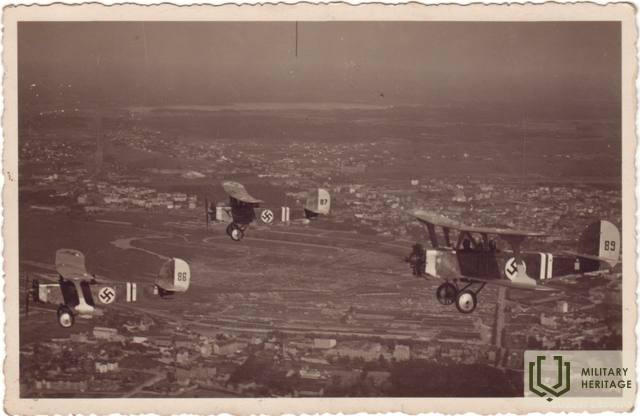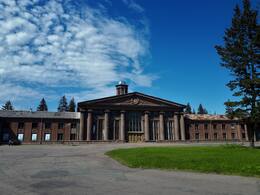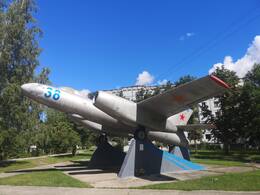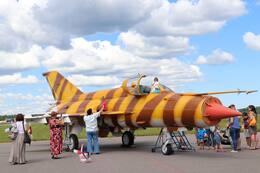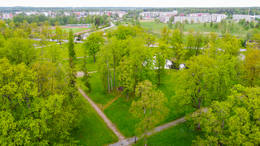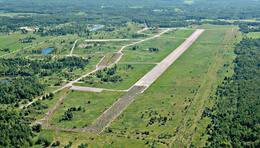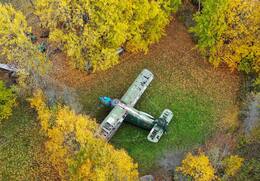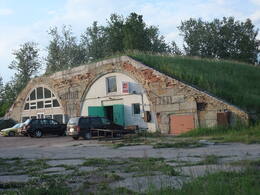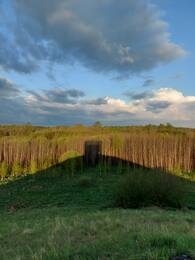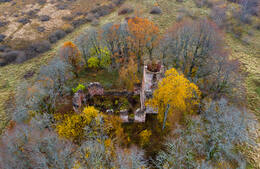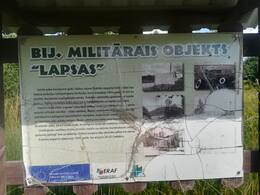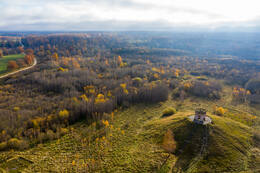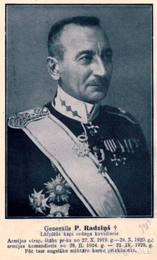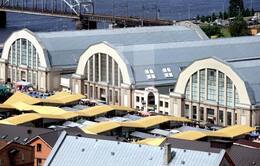Military aviation
I WW1, I Wars of Independence, Independence of the Baltic States, II WW2, IV Soviet Occupation, Restored Independence
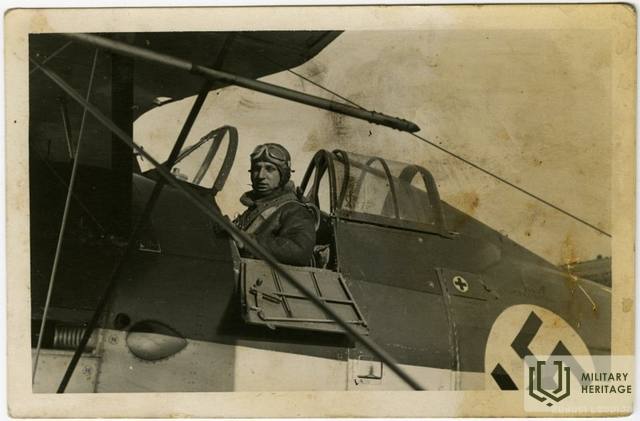
After the proclamation of the State of Latvia in the beginning of December 1918, the formation of the Latvian Armed Forces began.
On June 7, 1919, the Aviation Park of the Latvian Armed Forces was established (the motto - "Everything about Latvia!"), Alfreds Valeika became its first commander. In 1921, the Aviation Park was transformed into the Aviation Division, and on September 18, 1926, into the Aviation Regiment.
From 1919 to 1940, Latvian military aviation became the strongest in the Baltic States. At that time, Latvian aviation had planes built in its own factory in the workshops of VEF and the port of Liepaja. There were also planes from Europe, mainly from England. The aviation regiment consisted of fighter squadrons, reconnaissance squadrons, naval squadrons, and aviation school units that trained pilots and specialists for all necessary services. In 1939, the Aviation Regiment included: the regiment's headquarters in Riga, 8 operational squadrons (60 aircraft, 120 pilots and 80 specialists), a military aviation school, repair shops, and a supply warehouse.
The Aviation Regiment officially ceased to exist on December 25, 1940, after the occupation of Latvia by the USSR.
After the restoration of Latvia's independence, the renewal of the Latvian Defense Forces also began. On February 24, 1992, the Air and Air Defense Board was established at the Headquarters of the Defense Forces, which was later transformed into the Air Force Headquarters. On June 17, 1992, the Minister of Defense signed an order to renew the Air Force.
More information sources
Avoti:
https://www.mil.lv/lv/vienibas/gaisa-speki
Related objects
Spilve airport
Located in Riga, Pardaugava, Spilve meadows near Ilguciems.
Spilve is famous in the history of military heritage for the large-scale battle of Spilve in the 18th century. and Spilve Airport. Beginning in the 20th century, it was used to test aircraft, but in World War I it became a witness to the history of Latvian aviation.
In World War I, Spilve meadows were used for the needs of the Russian Air Force in the fight against the German Army. With the establishment of Latvia, the airfield became the most important base of the national air force and a place for pilot training. The previous names of the airport were "Spilve Airport" or "Riga Airport", later "Riga Central Airport". It was the main airport in Latvia until the opening of Riga Airport in 1975.
It is possible that Spilve Airport near Riga and the dream of reaching for the stars have contributed to the impressive achievements of many Latvian pilots. Perhaps, however, the beginning of Latvian aviation is much older and can be found in Priekule, where a Latvian blacksmith Zviedris made a flight from the church tower with a homemade device.
Today, Spilve Airport is still open. You can see the airport building built in 1954, which embodies the style of Soviet classicism or "Stalin's Empire".
Sources:
Irbītis, K. Latvian Aviation and Its Pioneers. Riga: Science, 2004.
Brūvelis, E. History of Latvian Aviation: 1919-1940. Riga: Science, 2003.
Official website of the State Agency "Civil Aviation Agency". Available: https://www.caa.gov.lv/lv/latvijas-aviacijas-vesture-isuma [accessed 22.02.2021].
Riga Airmuseum (Riga Aviation museum)
The Riga Air Museum is located in Skulte village, Marupe municipality, in the territory of Riga Airport, next to the aircraft observation area. It is a privately made tourist attraction that opened in 1997. It has taken more than 50 years to create this collection. Aviation equipment has been gathered from Latvia, Russia, Poland, Ukraine, the Czech Republic and the USA. It is one of the largest and most valuable collections in Europe. The idea of a Latvian Aviation Museum was conceived at least 80 years ago. The history of Latvian aviation dates back to the time when the world's first aircraft were being developed. Latvian pilots were among those who participated in achieving many world records. After World War I and the Latvian War of Independence the Latvian Army started to form an air force, and there was a need to preserve historical evidence. In the 1930s, there was an opportunity to start work on creating a museum. It already had acquired some particularly valuable historical items in its collection. World War II thwarted this project and the collection was lost. Nowadays there are about 40 aircraft objects, mainly manufactured in the Soviet Union. And the exposition gives an insight into the history of Soviet aviation.
Skulte airplane IL-28
Located in Mārupe region, Skulte village, near Riga International Airport.
Skulte was one of the typical villages that was created for Soviet military personnel. There was an aviation unit that bombed the cities of Berlin and other places in 1941, as well as took part in the occupation of the Baltic States. In 1978, an environmental facility, the IL-28, was installed there to highlight the merits of Soviet Army pilots in World War II.
After the war, the Soviet Union continued its active armaments policy. IL-28 was the first, most produced Soviet jet bomber. The first RDS-4 atomic bomb ("Tatiana") was dropped from a plane of the same model in 1953 to test the army's ability to attack after a nuclear explosion. The aircraft had various modifications. In tests, it reached a speed of 906 km / h, carrying several tons of heavy cargo and flying 2,445 km. It was run by a crew of 3 people.
The plane is not only a witness to the military heritage, but also a symbol of ideology. In 2010, marking the victory of the Soviet army over Germany, the plane was rebuilt. There have also been several unsuccessful attempts to dismantle it as an object glorifying the occupation regime in Latvia.
Today you can see a plane, as well as get an idea of a village built for Soviet military personnel.
Aviation Museum “SKY ZOO”
The Aviation Museum “Sky Zoo” is located in Smārde parish, Tukums municipality, in the territory of Jūrmala Airport that was once the Tukums Military Airfield. The exhibit includes aircrafts YAK-40, AN-2, SU22M4, PZL TS-11 Iskra and a helicopter MI-24. Tour of the airfield includes hangars, caponiers and engineering equipment. The airfield was used by both the German and Soviet armies. During the Soviet occupation it was one of the most important military airfields in the territory of Latvia. The fighters stationed there were intended to attack enemy ships and bomb coastal fortifications. On the night of 9 November 1975, a battle alarm was received at the Tukums airfield – there was enemy warship in the territorial waters of the Soviet Union (in the Gulf of Riga), and it had to be destroyed. Several planes took off from Tukums. However, it turned out that it was the Soviet naval warship ‘Storozhevoi’ (Guardian) on which an armed mutiny against the existing Soviet regime took place. When the planes reached the warship, the battle was still ongoing. Later the rebel leader Valery Sablin, a Soviet naval officer, was wounded and the mutiny ended. He was sentenced to death for treason. This was one of the most dramatic events showing the discontent with the regime and marking the approach of its collapse.
Latvian military aviation aerodrome
Located in the territory of Vecgulbene manor - in the historical center.
In the interwar period, the garrison of the Latvian Army was located in Gulbene, where the 7th Sigulda Infantry Regiment Battalion was stationed. Aerodromes are especially important in places where important railway and road junctions have been established. In 1937, a newly established unit of the Aviation Regiment was stationed in Gulbene, which became the 6th Division of the Latgale Division Scouts, increasing the number of army units near the eastern border of Latvia.
The conservatory building is visible.
Vaiņode air base
Vaiņode airfield still has 16 Soviet-era aircraft hangars and an 1800 m section of the once 2500 m long runway. The airfield can only be visited with a previous booking. Vaiņode airfield was established during the Latvian independence as one of the cradles of Latvian aviation and was later one of the largest military airfields in the Baltic States. In 1916, two hangars for German Army airships were built. Airships were used to gather intelligence and bomb the positions of the Russian Army. Later the city of Riga bought the airship hangars and used their roof structures to build the pavilions of the Riga Central Market. In May 1940, the 31st Fast Bomber Aviation Regiment of the Red Army moved to Vaiņode, and the construction of a standardized concrete slab runway began. At the end of the summer of 1944 the partially completed airfield was used by various German aviation units, however, at the end of World War II, the same airfield was used by the Red Army aviation units fighting the German Army group called ‘Kurzeme’. After World War II the Soviet Air Forces were stationed in Vaiņode until 1992.
Kurzeme fortress museum in Zante
The museum exposition (the only museum dedicated to the Kurzeme fortress) tells richly and engagingly about the course of warfare in the Kurzeme fortress and the future fates of Latvian soldiers. On the other hand, in the open-air exhibition, you can walk around and see the restored wartime trenches, bunkers and heavy military equipment.
Working hours:
Monday - Tuesday - closed
Wednesday - Saturday - 10:00 - 17:00
Sunday - 10:00 - 15:00
It is advisable to contact in advance by phone 29442311.
Rumbula Air Base
It is located in the southeast of Riga, in Rumbula, between Maskavas Street and the Daugava River.
In Rumbula there was an air base of the Soviet Army Air Force and a civilian airport next to Riga's main airport in Spilvė. Both airports existed until the opening of the "Riga" airport. Before the Second World War and the occupation of Latvia, the airfield of the Aviation Regiment of the Latvian Army was located in Rumbula.
After World War 2, the Soviet Union began producing jet-powered aircraft, which required longer and smoother runways. Old airfields were expanded and new airfields were built. The changeable weather conditions of the Baltic and the short flight time of the first jet planes were the reason to build many reserve airfields. The noise of the jet planes caused dissatisfaction among the residents of Riga, because the military airfield was too close to residential areas and could create dangerous situations. In 1973, it was closed and the Lielvārde airfield was built in its place, to which fighter planes were transferred. Shortly before the closure, there was an international scandal. A US Air Force officer who was one of the military attachés in Moscow was beaten there. He was allegedly attacked by 14 - 20 airport employees, who suspected that the airport was being photographed.
Today, you can see the abandoned airfield area.
Soviet air force target firing ground in Zvārde
Zvārde landfill is located in Zvārde municipality, Saldus region. It is a former military aviation training ground of the USSR, covering more than 24 000 hectares.
The territory of the former airfield is home to several sites: the Officers' Kurgan, the ruins of the Zvārde and Ķērkliņi churches, the Rīteļi cemetery, the former army base "Lapsas", and others. Until the Second World War, the site of the observation tower was home to the "Vairogi" house. During the construction of the polygon, what was left of the farm - walls, the remains of the apple orchard, and part of the ruins of the Veczvārde manor - was piled together to form a mound and the observation tower was built on it. It was used as an observation point for coordinating the army's training manoeuvres. This place is popularly known as Kurgan. The mound overlooks the former training ground and the wooded areas of Zvārde Nature Park and Nature Reserve. A good place for bird watching. The surroundings of Kurgāns are not landscaped.
Ruins of Ķērkliņu church
The ruins of the Ķerkliņu Church are located about 5 kilometres north-west of Kokmuiža, near the Ķerkliņu Lake. The church was built in 1641 by Heinrich von Dönhoff (Derkarth), the owner of the Ķerkliņi manor. The original wooden church was replaced by a stone building, under which tombs were built for the dead of the Dönhof and later Kleist families. The tombs were already destroyed during the 1905 riots, but in 1949 the coffins were moved from the tombs to the church. The church was an example of the Kurzeme Baroque style - its carvings were made by the Kuldīga - Liepāja woodcarvers. Although the owners of the manor and the church were at various times plagued by financial problems, the church underwent several reconstructions during its existence. It also suffered during the First World War, after which the parish rebuilt the stonework in 1929 and added an organ in 1934. Unfortunately, the church was damaged during the Second World War and much of it was lost, so it is to be commended that before the church was rebuilt in 1933, many unique pieces of Baroque sculpture were photographed, inventoried and even ended up in the archives of the Monuments Board. With the establishment of the landfill and the eviction of the inhabitants, the church was never restored. Today, the church walls and tower are visible.
Zvārde shooting range and former Soviet military base "Lapsas"
The landfill's service base is located approximately 2 kilometres east of Striķu Manor, on the Saldus-Auce road. The former Soviet Military Aviation Target Range (military unit No 15439) in Zvārde is located south of Saldus. The territory of the airfield is home to several sights - the ruins of Zvārde and Ķerkliņi churches, the ruined Rīteļi cemetery, the observation post of the airfield, the so-called "Officers' Kurgan" and the former airfield personnel base and shooting range "Lapsas".
The Zvārde air target range required a unit of approximately one company to service the air target range - to install targets, repair damage, guard the air target range and coordinate air flights. It was based on the site of the house called "Lapsas" until the Second World War. With the construction of the airfield, barracks, transport sheds, a flight control tower and a firing range for training personnel were built.
After Latvia regained its independence, the Zvārde Defence Forces Training Centre operated here, but since 2007 the site has been owned by the municipality and leased by several hunting collectives. The former barracks house an exhibition on the history of Zvārde parish.
Soviet Army Observation Tower (Kurgan of Officers)
The "Officers' Kurgan" is located less than a kilometre from the ruins of Zvārde Church. The Kurgan is made of the ruins and remains of the surrounding houses and manor house, which have been bulldozed together. An observation tower was built on the kurgan. According to the inscription, the present tower was built in 1981. The tower was used to record bomb hits. The training bombs had a reduced explosive content, so their hits had to be watched more carefully. Unexploded bombs were neutralized immediately, but not all could be found.
The remains of the tower can be seen here today - the brick walls. As the barrage is relatively high, you can even see the Lithuanian oil refinery in Mažeikiai on a clear day.
Memorial place of General Pēteris Radziņš
Located in Valka parish, driving on the road Valka - Rūjiena (P22) 4 kilometers, to the right, following the signs.
Pēteris Radziņš was born on May 2, 1880 in Lugavis Parish, Jaunvīndedze. Studied at Lugaži Parish School, Valka City School and Valka Nelson Real School. Joined the Russian army as a volunteer. In the autumn of 1919, he returned to Latvia and on October 27 was appointed Chief of Staff of the Commander-in-Chief of the Army, assuming this position at a time when the Bermontians were threatening Riga. As the chief of staff, he has led all the battles of Riga, Zemgale and Latgale. Promoted to General on February 5, 1920.
Today, a memorial stone dedicated to General Pēteris Radziņš (1880 - 1930) can be seen near the family house.
On November 11, 2017, a memorial plaque to Pēteris Radziņš was unveiled in Riga, at the corner of the Daugava gate.
Video: Memorial event of General P. Radziņš in Riga Brothers Cemetery in 2019
Video: On May 2, 2019, on the 139th birthday of General Pēteris Radziņš, a commemoration event took place on the embankment of November 11, near the Presidential Palace, covering the memorial plaque to the guard of honor and those interested.
The exposition of Valka Local History Museum “Valka - the cradle of Latvia's independence” also reflects the life and work of General Pēteris Radziņš.
In addition to the traditional ways of displaying the collection, the exhibition uses interactive multimedia solutions. Information and annotations translated into Estonian and English.
Zeppelin hangars of Riga Central market
Located in the center of Riga, opposite the Riga International Bus Station, near the Riga Railway Passenger Station.
Riga Central Market is the largest market in Latvia, which was once recognized as the best and most modern market in Europe. Its bright symbol is the 20th century. Market pavilions built in the 1920s and originally used for military purposes.
During World War I, the German army established Vaiņode Airport in Kurzeme, where several airships were permanently located. These were elongated-shaped balloons filled with gas and enclosed to carry passengers and cargo. Control was provided by an internal combustion or electric motor and a wing in the housing. The airships were intended for reconnaissance or for bombing an enemy, for example, by attacking a Russian army seaplane airfield on the island of Roņi. The hangars are known to be called Walhalla and Walther.
After the Latvian War of Independence, the hangars were dismantled and used to build the hangars of the Riga Central Market, planning to leave them in their original size. It was later decided to use only the upper parts of the hangars.
Today you can see the metal structures of the German army airship hangar. The market provides a pleasant way to learn about the origins of world aviation. Tour application: +37167358157; gints.aksiks@rct.lv.
Riteli Cemetery
After the airfield was established in this area in 1953 at the request of the USSR Ministry of Defence, the Zvārde Church, the Ķerkliņi Church and the Rīteļi Cemetery were actually located in the centre of the airfield - next to an artificial airfield with access roads and defence positions, which was used as a target by Soviet pilots. Planes flew here from airfields in Latvia and elsewhere in the Soviet Union. In less than 40 years, the church, the cemetery, the former manor house and dozens of surrounding buildings were reduced to ruins. Today, the site is cared for by the Saldus Martin Luther Church. The surrounding area is still contaminated with unexploded ordnance and it can be dangerous to walk off the roads.
Barbarism reached its peak in 1988, when the Rīteļi cemetery with its graves and monuments was bulldozed.
On 21 July 1990, in one of the first actions in which the Latvian population demanded that the USSR army leave the territory of Zvārde, a protest rally was held in Saldus, after which people went to the Rīteļi cemetery. The rally participants were allowed into the landfill site, and they cleaned up the cemetery a bit and dug white crosses.
The landfill continued to be used until 1992 and even as late as March 1992 a plane taking off from Lielvārde crashed in the landfill for unknown reasons. The Latvian Defence Forces started demining the site in May 1993, after the withdrawal of the Russian army. In 2008, Zvārde residents installed a memorial stone "Forgive us for not saving you" in the Rīteļi cemetery.
“Jāzeps Baško – Gaisa Fūrmanis” (“Jāzeps Baško – Air Cabman”) Exhibition of Preiļi Museum of History and Applied Arts
The “Jāzeps Baško – Gaisa Fūrmanis” (“Jāzeps Baško – Air Cab man”) exhibition is dedicated to the 125th birthday of General Jāzeps Baško, the commander of the “Iļja Muromec” squadron and the organiser of the Latvian Air Force, and to the 100th an niversary of World War I.
The exhibition of the museum collection resembles a design object – a model of the Ilya Muromets aircraft that has been reduced in size 6 times, with information in the form of texts and images provided on the model. The exhibition is enriched by ex hibits from the collections of the Latvian War Museum and newly acquired information from the Latvian State Historical Archive, the Spilve Aviation Museum and private archives of individuals. Jāzeps Baško is rightly one of the most awarded Latvians and pioneers of global aviation. He set 4 global aviation records flying Ilya Muromets aircraft. His name is inscribed in the Louis Blériot Golden Book in Paris, i.e., the Golden Book of the world’s best aviators. Jāzeps Baško was awarded all orders of the Russian Empire of his time, in Latvia – the Order of the Three Stars, 3rd Class, the Order of Viesturs, 2nd Class, the Home Guard Cross of Merit, as well as the highest awards of Czechoslovakia, Estonia, Finland, and Poland.
He served in the army of the Russian Empire, the Bolshevik Red Army, and, in 1921, he joined the Latvian Army. He retired from service after the occupation of Latvia.
Zoknių aerodromas
Šiaulių miesto dalyje, vadinamoje Zokniais, nuo tarpukario laikų veikė aerodromas, vėliau tapęs oro uostu.
1931 m. Zokniuose nuspręsta įkurti aerodromą, lygūs laukai ir žvyruotas gruntas puikiai tiko lėktuvams. Birželio 1 d. iš Kauno į Zoknius perkelta 3-oji ir 4-oji žvalgybos eskadrilės, kurioms priklausė lėktuvai LVG C.VI ir Albatros C.XV. Buvo pastatyti angarai, štabo pastatas ir kareivinės, o pirmuoju bazės viršininku tapo majoras Leonardas Peseckas.
Augant Lietuvos karo aviacijos pajėgumams, Zoknių aerodromas plėtėsi: čia buvo pastatyti nauji angarai, lėktuvų remonto dirbtuvės, įkurtas poligonas bombų mėtymui netoli Šilėnų. 1937 m. į Zoknius buvo perkelta 5-oji eskadrilė su naikintuvais „Letov Š-20“ ir FIAT C.R.20, o 1938 m. šiuos senus naikintuvus pakeitė modernūs Gloster Gladiator, pasižymėję puikiais rezultatais Suomijos–SSRS (Žiemos) kare.
1936 m., vykdant S. Raštikio kariuomenės reformas, karo aviacija buvo decentralizuota, o Zoknių aerodromas tapo viena iš pagrindinių šalies karinių bazių. Karo aviacijos pajėgos čia plėtėsi, įsteigtos aviacinės dirbtuvės, kurios prisidėjo prie lėktuvų priežiūros ir remonto, o vėliau jose dirbo žymūs konstruktoriai, kaip Bronius Oškinis. Zoknių aerodromas tapo strateginiu tašku, kurio svarba augo dėl šalia esančių branduolinių ginklų dislokacijos sovietmečiu.
2005 m., reikalaujant miesto verslininkams, buvo įsteigta Šiaulių miesto savivaldybės įmonė „Šiaulių oro uostas“. Lietuvai tapus NATO nare prasidėjo ir aerodromo pakilimo takų remontas: 2005 m. atlikta atsarginio kilimo ir tūpimo tako rekonstrukcija. Lėšas skyrė NATO.
Pagrindinio kilimo ir tūpimo tako rekonstrukcija oficialiai baigta 2006 m. spalio 26 d. iškilmingu tako atidarymu. Rekonstruoto aerodromo apskraidymą ir sertifikavimą atlikę specialistai pripažino jį geriausiu visoje Rytų Europoje.
Related stories
Riga Central Market hangars
At the time of the creation of the Riga Central Market, it was one of the most modern markets in the world. It was based on the metal construction of the hangars of the German army airships of the First World War. The author describes the preconditions for the construction of the Riga Central Market and the scope of construction works, making it one of the largest buildings after the war in Latvia and one of the most modern markets in the world.
Aircraft engine testing laboratory
During the Soviet era, there was a strange object north of Spilves Street, if the memory is not wrong - with two low rectangular "mega-chimneys" built of red bricks, from where a reactive sound similar to the roar of aircraft engines was quite often heard.
Memories of Spilve helicopter base
During the Soviet era, there was a helicopter base in the southwestern part of Spilve Airport. It could be well seen from the nearby Kleistu forest dunes, as well as from the Riga-Bolderāja railway branch, which led to the Riga varnish and paint factory.
United Aviation Festival - a real national holiday
The narrator describes one of the most popular and widely attended events in Latvia - the Aviation Festival in Spilve. Describes the course and scope of the festival. The popularity of aviation in Latvia is emphasized.
Skulte military bomber
An article in a newspaper vividly demonstrates the situation in modern Latvia, when environmental objects glorifying the Soviet occupation army have been preserved and even restored in many places (often at the expense of the municipality). The indecision of power and the lack of will create long-lasting, confrontational situations in society. The various monuments, memorials and environmental objects are not perceived as places of history or memorial, but as instruments that continue the ideology of the Soviet occupation regime.
The secret of Tukums airfield
Tukums airfield keeps a secret that no one has solved yet - is there really a nuclear missile warhead in the territory of the airfield, which is ordered there by the special service of the Russian army, I left the airfield in the 90s?
Were nuclear warheads buried at Tukums airfield?
Former commander of the guard Aivars Skurstenis has applied for an open conversation to the Tukums district newspaper "Neatkarīgās Tukuma Ziņas". He was once a reserve officer and a front-line bodyguard, who in 1993 was offered a guard position in the agricultural company "Durbe" headed by Laimonis Mucenieks. The office - Līvāni house - had to be guarded there. That is the beginning of the story.
War airfield near Tukums
Today, in Soviet times, army destroyers stood in barely visible, overgrown hangars on the highway to Tukums. Even in those days, the airfield with hangars was disguised and ignorant people did not know about it.
Flight to Vaiņode airfield
The story of the German air raid on Vaiņode airfield in June 1941
Tukums reserve aerodrome management in the 90s.
With the departure of the Soviet occupation forces, the looting of many former war bases began. Soviet soldiers tried to take out as much as possible and leave the degraded infrastructure. After the departure of the troops, these bases continued to be looted by civilians and to exploit former military infrastructure.
The bombing of Rezekne in 1944
The bombing of Rēzekne took place at Easter 1944, and as a result a large part of the city's buildings were destroyed and dozens of civilians were killed, while several thousand more were left homeless. People who have experienced these events on their own skin and can tell us about them were children at the time. One of them is also the author of this story.
Pranks and games with military ammunition
After the Second World War, the land of Latvia was full of the physical remnants of the war. It was a large number of rounds, unexploded ordnance and simple cartridges. Even today, especially in places where there has been active warfare, unexploded ordnance is found, which is very rare, while in the post-war years these charges in the forests and even in the courtyards were the everyday life of the inhabitants and even children's toys.
Soviet aircraft bomb Riteli Cemetery
The Riteli cemetery was actually located in the centre of the target area. The locals could only watch as they were destroyed.
Zvārdenieka's childhood in the shadow of bomb explosions - Polygon summers
Spending my childhood near the Zvārde target range, under the sounds of explosions and flying jet planes, but still sometimes on weekends I could enter the range. After the departure of the Soviet army, the land was littered with bomb craters and many explosive objects, not only from the time of the landfill, but also from World War II.
Zvārdenieka's childhood in the shadow of bomb explosions - Phosphorus capsules
Spending my childhood in the vicinity of the Zvārde target range, under the sounds of explosions and flying jet planes, but still sometimes on weekends I could enter the range. After the departure of the Soviet army, the land was littered with bomb craters and many explosive objects, not only from the time of the landfill, but also from the 2nd World War. Especially the boys liked to burn phosphorus capsules ...
Zvārdenieka's childhood in the shadow of bomb explosions - the fallen plane
The use of the landfill continued until 1992, and even in March 1992, a plane that took off from Lielvārde crashed in the territory of the landfill for unknown reasons.
Zvārdenieka's childhood in the shadow of bomb explosions - the fallen plane
The use of the landfill continued until 1992, and even in March 1992, a plane that took off from Lielvārde crashed in the territory of the landfill for unknown reasons.
The story of Cīrava airfield
Cīrava airfield - created during the Second World War, used by the Soviets as a DOSAAF airfield, currently used for agricultural purposes and recreational trips, as well as Soviet-era aircraft on display in the hangar
Mig-27D planes crashed at the Zvārde landfill and Ledurga
At the beginning of 1992, on one day, under mysterious circumstances, two "war" planes produced during the Russian Soviet era crashed at the Zvārde training ground and Ledurga, 40 minutes apart.
Russian military planes crash in Ledurga and Zvārde landfill
At the beginning of 1992, two Soviet Mig-27 D planes crashed on one day in mysterious circumstances with an interval of 40 minutes in Ledurga and Zvārde landfill.
About the grave of the downed pilot
In the First World War, new technical means were massively used (machine guns, poisonous gases, tanks, submarines, artillery tornado tactics, flamethrowers, combat aviation), which increased the amount of human killing to an unprecedented level. It is said that the last knightly battles were fought in the air because of mutual respect and unwritten rules between the pilots. At the beginning of the war, when the planes were not yet equipped with weapons and flew on surveillance missions, the pilots of the opposing sides even greeted each other in the air. On the other hand, the enemy pilots who were shot down or captured later used to inform the other side by flying to the enemy airfield and dropping a piece of paper in a sandbag or even the report of the captured pilots.




